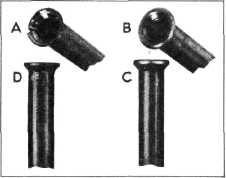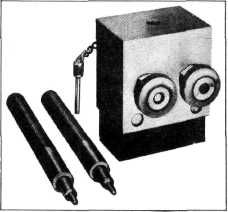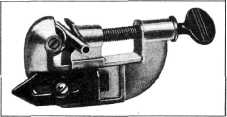1942 - 1947 CHEVROLET SHOP MANUAL
Section 5 - Brakes
|
|
|||
|
5-4 |
|||
|
|
|||
|
by the
pistons to lubricate them, the glucose will form a sticky rim around the cylinders,
preventing piston
action.
The fourth
type, or mineral oil such as motor oil in shock absorber fluid, is the one to
guard against most strenuously.
Even slight traces of mineral
oil are enough to destroy the sealing qualities of the rubber cups in
two or three days. Cylinders and parts should never be washed in
gasoline, as even the small
amount of mineral oil present in gasoline will affect the rubber
seals.
The last
named type, or plain alcohols, most of which contain up to 10% water, should never
be used as the alcohol has no
lubricating properties at all and, due to its extreme thinness, will leak
past the rubber cups and saturate the brake linings.
In the
event that improper fluid has entered the system, it will be necessary
to—
1. Drain the entire
system.
2. Thoroughly and vigorously flush the
system with clean alcohol, 188
proof, or a hydraulic brake
system cleaning fluid known to the industry as "Declene."
3. Replace all rubber parts of the system
including brake
hoses.
4. Refill the system with G. M. Hydraulic Brake
Fluid, Super No.
9.
HYDRAULIC BRAKE TUBING
The
hydraulic brake tubing is a double layer flexible steel, copper-coated, tin-plated
tubing which resists corrosion and also stands up under the high pressures which are developed when
applying the brakes. |
The
important thing in connection with making up hydraulic brake pipes is the proper
flaring of the ends of the tubing for the compression couplings. Unless the tubing is properly flared
the couplings will leak and
the brake will become ineffective.
This
safety steel tubing must be double-lap flared at the ends in order to produce a
strong, leak-proof
joint.
The brake
tube flaring tool shown in Fig. 6 is used to form the double-lap
flare. |
||
 |
|||
|
Fig. 7— Single and Double Lap Flare on Tubing
End
Fig. 7 shows two pieces of
tubing—one with a single-lap flare
("A") and the other with the double-flap flare ("B"). It will be noted
that the single-flap flare
split the tubing while the one shown in "B" has a heavy, well-formed
joint.
DIRECTIONS
1. Cut the
tubing to the desired length, using a tube cutter to prevent flattening the
tubing. Square off the end
with a fine-cut mill file, then ream the sharp edges with the reamer blade
provided on the tube cutter,
Fig. 8. |
|||
 |
|||
 |
|||
|
Fig. 8-Cutting Hydraulic Brake Tubing
2. Place new compression coupling
nuts on the tubing. Dip end of tubing
to be flared in hy- |
|||
|
Fig. 6-Hydraulic Brake Tubing Flaring
Tool |
|||
|
|
|||